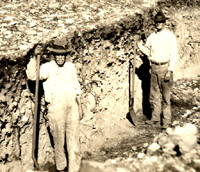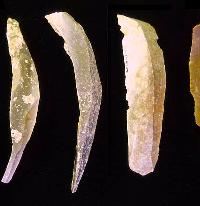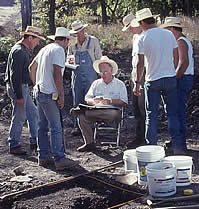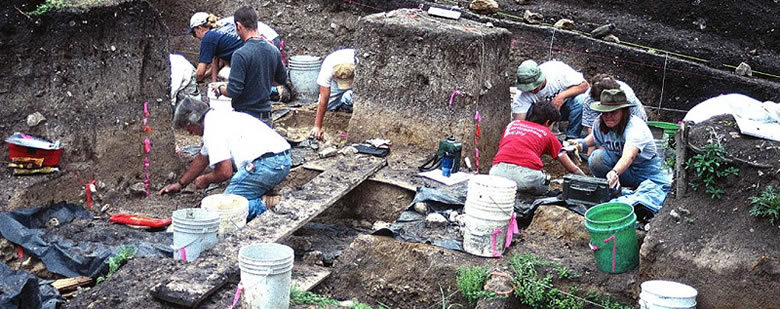
Two of many Clovis points from the
Gault site.
Click images to enlarge
|

View of the 1930 excavations at Gault
under the direction of James E. Pearce. Pearce focused
on one of the most obvious archeological features at
the site—a massive burned rock midden—the
thick rocky layer extending from the surface to below
the workmen's waists.
|

Clovis blades. |
|
The Gault site, midway between Georgetown and
Ft. Hood in central Texas, has a long history of archeological
investigation as well as uncontrolled artifact digging. Located
in a small wooded valley with a spring-fed creek and an unlimited
supply of excellent flint, the site was occupied intensively
during all major periods of the prehistoric era. James E.
Pearce, the first professional archeologist in Texas, learned
of the Gault Farm site and excavated there in 1929-1930. Over
the next 60 years, artifact collectors churned up the upper
deposits over almost the entire site, but stopped digging
when the dark rich midden soil played out. In 1990, an artifact
collector dug deeper and found Clovis artifacts along with
several unusual incised stones, something never before found
with Clovis materials. Learning of the find, Drs. Thomas R.
Hester and Michael B. Collins of the Texas Archeological Research
Laboratory carried out testing at Gault in 1991, just enough
to confirm the collector's story. But the property owner at
the time continued to let pay-to-dig artifact collectors destroy
the site.
Fortunately for archeology, the property changed
hands and the new owners recognized the scientific importance
of the site. Since 1998 a major excavation project has been
underway at Gault, led by Collins. The work has been carried
out by a cast of hundreds of individuals representing dozens
of organizations. A relatively small core of professional
staff works with university field schools from Texas A&M,
UT Austin, and Brigham Young University as well as volunteers
from near and far including many members of the Texas Archeological
Society.
The Gault site is attracting national and international
attention because of the wealth of new information on Clovis
culture that is emerging from right here in the heart of Texas.
In Clovis
Reconsidered you will learn about the unfolding interpretations
of what Clovis life was like 13,000 years ago at the Gault
site and how these ideas are helping to mold a dramatically
new view of the peopling of the Americas. You can also look through the TAS
Field School Gallery for pictures of the 2001 Field School
and TAS members taking part in the exciting investigations
at Gault. Credits and Sources provides
links to additional sources of information.
|

Clovis blade core.
|

Major excavations began again in
1998 at the Gault site. Here archeologists in standard-issue
white cowboy hats gather around Dr. Tom Hester who is
examining a Clovis artifact.
|
|

